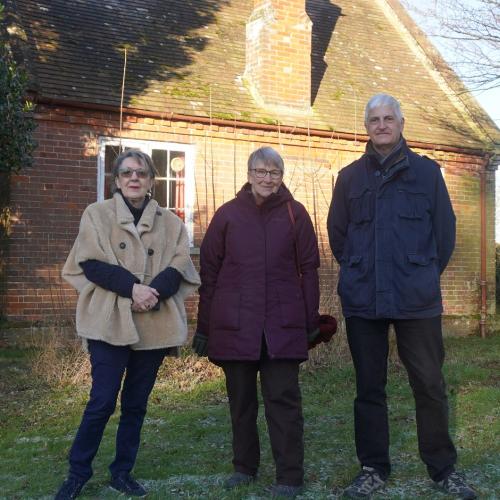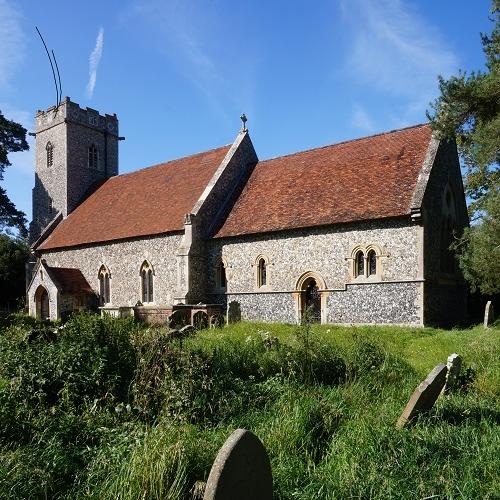 It’s rare to find a churchyard without trees. Many of them are venerable and they are as well established a part of the landscape and townscape as the churches that they neighbour. All are important as sources of oxygen and habitats for wildlife.
It’s rare to find a churchyard without trees. Many of them are venerable and they are as well established a part of the landscape and townscape as the churches that they neighbour. All are important as sources of oxygen and habitats for wildlife.
A tree within the boundary of a churchyard will almost always be covered by the faculty jurisdiction. That means that you may need permission from the Diocese to carry out works to it. The most common matters, such as pruning, fall under List A (no formal permission required, just record for future reference) and List B (authorised by the archdeacon). But you may sometimes need to fell a tree. If it’s damaged or dead, or else if it’s become dangerous, that’s a List B matter. But felling a healthy tree always requires a full faculty. Usually, that’s necessary because the tree roots are affecting a nearby building or structure. If that’s the case, we’ll need professionally verified evidence of the damage that’s been caused. You’ll also need to notify your local council of your intention to fell the tree. If it’s covered by a tree protection order, you may need to obtain permission to carry out any works on it at all. Check with the tree officer at your local council for further information.
Your first step may be to find out if your parish has a tree warden here. Your tree warden may also be interested in collecting seeds from your older or ancient trees in the view to growing new saplings for use elsewhwere.
Generally the planting of trees falls under Schedule 1, List B (B7.1): matters which may be undertaken without a faculty. Regard must be had to the guidance issued by the Church Buildings Council:
Tree planting guidance | weblink
To ensure that tree planting proposals are carefully designed, planned, and managed, the DAC recommends that the following documents are submitted along with the list B application and offers the accompanying advice. This will help make the process as quick as possible.
1) A planting plan for the area in the churchyard to be planted might be requested
The DAC recommends that PCCs have a plan of the churchyard:
- The archdeacon might ask to see a plan, if there are concerns about what you want to plant, or the number of trees being planted.
- Ideally, if a plan is requested, it should be marked-up with dots and approximate canopy circles for existing trees and large shrubs. This might be based on a tree survey you have for the churchyard.
- A schedule or key can be used to indicate all species.
- Proposed new trees and shrubs should be marked with a simple cross/+. A schedule can be added or attached.
- A colour plan might be helpful to highlight new trees but is not essential.
Please note: If any trees need to be removed, these should also be indicated. The felling of a healthy tree requires a faculty. The felling of a tree that is dying or dead, or has become dangerous, falls under Schedule 1, List B (B7.2). Specified conditions apply.
2) A list of the species of trees the PCC would like to plant, how many and where
These can be marked on your churchyard planting plan. The DAC favours native trees, which are in-keeping with the natural surroundings, habitat, and ecosystems. However, non-native trees such as ornamental crab, cherry, Ginkgo, evergreens (such as Cedar) and many others might be appropriate, particularly where you wish to enhance the churchyard and create a specific effect with ornamental flower, leaf colour and/or evergreen foliage.
The DAC is unlikely to support species which might look out of character or be problematical in future such as Cupressus, Eucalyptus or laurel. Species which bear poisonous fruit/berries and flowers such as laburnum should be used with care. Yew is of course a traditional churchyard tree so could be an exception.
When selecting your trees, please consider other factors such as, proximity to the church, other buildings and structures, key views of the church, churchyard, and other local features, shading from the church or nearby buildings, impact on wildflower grassland, the stability of structures such as headstones, box tombs, and churchyard walls, soil conditions, and access for tree management.
The overall size, height, span, and root depth/spread of the proposed trees once mature should be a key consideration. Make sure space is available to accommodate the tree when grown to full size. Or anticipate the management which may be needed, such as pollarding some lime trees. Consider who will maintain the tree/s and carry out formative watering/pruning so that they become well-established and thrive.
It is important that the overall effect and character required for the churchyard is considered. The local character of the churchyard and its setting/surrounding landscape should help inform suitable tree species and the approach to planting.
The DAC is likely to support a well-designed plan where it can be shown that proposed trees will enhance the churchyard, and where there is suitable space available.
3) Photographs of the area to be planted, including any established trees or shrubs might also assist your application
Further information
Church of England Care of trees advice and guidance | weblink
Caring for Gods Acre | weblink
Woodland Trust | weblink


